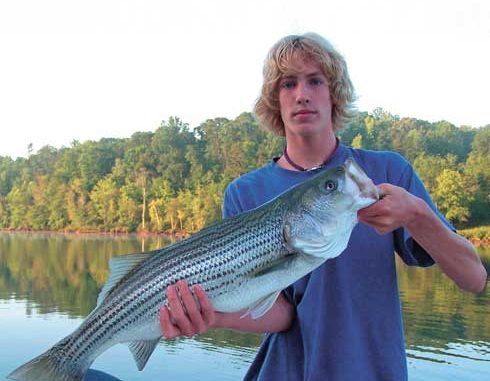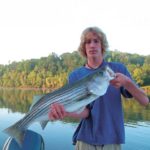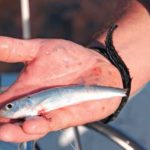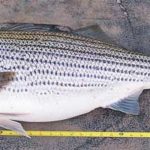
Want to learn how to cash in on Lake Hickory striped bass? Join the Clubb.
It doesn’t take much prompting to get David Clubb excited. Just call this month and ask how the striped bass are biting on Lake Hickory.
“The river bite is on!” he said.
Join the Clubb.
Although he admits he spends most of his time guiding for stripers on Lake Norman, he can’t wait for May when the trophy fish in Lake Hickory start working their way upstream and can be caught within a rifle shot of Rhodhiss Dam.
Unlike Norman, which is known for large numbers of hard-fighting but smallish striped bass, Hickory has a strong population of bigger fish, and catching a 20- or 30-pound fish out of this foothills reservoir on the Catawba River is a distinct possibility.
A lot of newly-indoctrinated striped bass fishermen find it hard to believe that stripers — the highest predator in the food chain in most southern reservoirs — would stoop to scavenging cut bait off the bottom like a catfish.
But whether you consider it stooping or not, some of the biggest rockfish of the year are caught during the spring months when they run up rivers and into tailraces during the spawn, and getting them to eat cut bait is one of the most productive tactics.
“Most people think of striped bass as these big, open-water predators that thrive on whole live baits that are bigger than what some fishermen catch when they go out fishing,” said Clubb, who hails from Mooresville. “That’s true, but during the spring, these big brutes answer the call of nature, and they instinctively head up into the rivers and headwaters for the spawn.”
While striped bass react to spawning urges and are capable of spawning, most inland reservoirs don’t provide the right conditions for success, which is why most North Carolina lakes are stocked annually to replace the fish that are harvested or die of natural mortality.
“My favorite spot on Lake Hickory is to anchor the boat out in the middle of the Catawba River above the railroad trestle that crosses the river between the Highway 321 bridge and the dam at Rhodhiss. There’s a fairly deep hole just above the trestle and a wide shallow flat on the right- hand side. A little further up, there’s a sheer cliff on the left side, and I can find a number of good spots anywhere between the trestle and that sheer rock cliff to get on some good, and I mean GOOD, fish,” said Clubb.
Using cut bait offers several advantages over most other tactics when fishing in this moving-water environment:
• Cut bait puts out scent that washes down with the current and helps stripers hone in on the bait.
• When moving upstream, stripers swim into the current with their heads down to reduce drag. This posture puts a cut-bait rig, complete with two ounces of weight, right in their face as they move along.
• By nature, big stripers are lazy. They didn’t grow to such proportions by expending a lot of unnecessary energy chasing healthy prey. They are smart fish who recognize that moving water, rocks, and dam turbines damage and injure prey — and finding an easy meal on the rocky bottom is eating smart.
When it comes to baits, Clubb finds it’s best to “match the hatch” and use river herring or alewives he can easily catch by throwing a cast net where the water boils in the tailrace immediately below Rhodhiss Dam. He prefers a 6-inch herring, a common size found in the tailrace.
“I like to get up there early and get my throws in the best spots before other anglers arrive,” said Clubb. “Then I can get set up and be fishing first thing and not trying to catch bait.”
Clubb uses two anchors when cut bait fishing. The bow anchor holds the boat in place, and the stern anchor keeps the boat from wobbling from side to side and pulling his lines into snags on the bottom. The current typically limits him to fishing only four lines out of the back of his boat. He sets up with two rods off each gunwale going straight back and an additional rod perpendicular to the boat to get a little spread in his offering. He’ll also stagger his casts so that one line is further out than the other on each side. This leaves the middle behind the boat open.
“I try to spread out the baits and have one down in a deep hole or the deepest part of the river channel and one or two up on a shallow flat where stripers often run up to feed. I also want a bait or two on the down slope from shallow to deep,” he said. “If there’s an eddy or bend where slack water collects, I’ll sometimes put a live bait on a split-shot and suspend that under a cork behind the boat.”
Unlike other cut-bait anglers who will often commit an entire day to one spot, Clubb gives each location and hour to an hour-and-a-half to produce, then he’s pulling anchor and heading to another spot. Unlike deep-water areas where he can spend some time motoring over the area and trying to mark fish, he has to fish a spot to know if fish are home or not.
“I figure this is fishing for traveling fish,” he said, “and while most of the fish will be in this part of the lake, they don’t pack into the channel and move all at one time. When you do get bites, you’re likely to get a flurry of activity for a while, and then the fish will move on and you’re back to either waiting or moving to a new spot.”
Club has several “holding areas” where he’ll look for stripers if the main channel isn’t producing above the trestle. His main destination is nearby Gunpowder Creek.
“There’s a point right inside the mouth of Gunpowder Creek where the channel makes a hard bend to the right. I can beach the boat with the nose right up on top of that point and have deep water within casting distance on either side,” Clubb said. “In that situation, I’ll use six rods and fan-cast all around the boat and hopefully catch the fish cutting across that point as they work back into Gunpowder.”
Another spot is the back end of Gunpowder Creek. The channel winds around a bit through a residential area before breaking back to the left in a long pond flat that goes from four feet deep in the back to 16 feet deep at the entrance.
“There’s always a ton of bait in the back of Gunpowder,” he said. “While the biggest part of that bait is shad, it’s a good place to look for staging fish if you don’t finding them moving in the river.”
Kenneth Tucker of Lincolnton, who like Clubb is a member of the Norman Fisheries Alliance and Lake Norman Striper Swipers, has fished Hickory enough to know that he can catch big stripers in the river no matter what time of year it is.
“The water coming out of (Lake) Rhodhiss is pretty cool year-round, especially in the summer when the rest of the lake gets hot,” said Tucker. “I’ve caught numerous fish that went over 20 pounds from the (Rt.) 321 bridge up to the dam, pulling the biggest live baits I could find.”
Tucker’s most common big bait is either a filetable-sized gizzard shad that he cast-nets in the back of Gunpowder Creek or a white perch caught on an ultra light rod. These big baits are hooked through the nose with a 3/0 to 5/0 hook and towed behind planer boards. He angler uses no weight, preferring to let the big bait find the right depth.
“The river is very narrow above (Rt.) 321. I try to run one bait up tight to the bank on one side, and I can reach the middle of the channel with the other,” he said.
Tucker suggests pulling one way up the river and then working the opposite bank going the other way. He said that trolling upstream with all the turbines running at Rhodhiss Dam can be tough, but many anglers believe the best bite occurs when the water is running. On the other hand, running downcurrent is also productive, but he has to be careful not to miss spots by going too fast.
“One thing about this fishing — prepare to get your feelings hurt,” he said. “Your chances of getting a bite from a 20-pounder are really good, but your chance of getting him in the boat is maybe 50/50.”







Be the first to comment